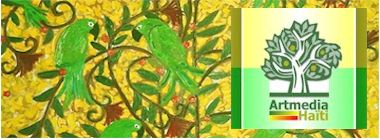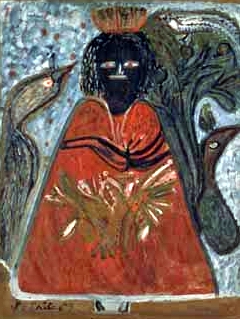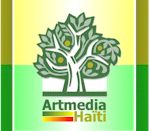
|
|
|
| --> Category: Orgins of Voodoo - AfroCentric Experience |
| |

|
| Voodoo is a derivative of the world’s oldest known religions which have been around in Africa since the beginning of human civilization. |
|
Some conservative estimates these civilizations and religions to be over 10 000 years old. This then identify Voodoo as probably the best example of African syncretism in the Americas. Although its essential wisdom originated in different parts of Africa long before the Europeans started the slave trade, the structure of Voodoo, as we know it today, was born in Haiti during the European colonization of Hispaniola. Ironically, it was the enforced immigration of enslaved African from different ethnic groups that provided the circumstances for the development of Voodoo. European colonists thought that by desolating the ethnic groups, these could not come together as a community. However, in the misery of slavery, the transplanted Africans found in their faith a common thread. They began to invoke not only their own Gods, but to practice rites other than their own. In this process, they comingled and modified rituals of various ethnic groups. The result of such fusion was that the different religious groups integrated their beliefs, thereby creating a new religion: Voodoo. The word -voodoo- comes from the West African word -vodun,- meaning spirit. This Afro-Caribbean religion mixed practices from many African ethnics groups such as the Fon, the Nago, the Ibos, Dahomeans, Congos, Senegalese, Haussars, Caplaous, Mondungues, Mandinge, Angolese, Libyans, Ethiopians, and the Malgaches. The Essence of Voodoo Within the voodoo society, there are no accidents. Practitioners believe that nothing and no event has a life of its own. That is why -vous deux-, you two, you too. The universe is all one. Each thing affects something else. Scientists know that. Nature knows it. Many spiritualists agree that we are not separate, we all serve as parts of One. So, in essence, what you do unto another, you do unto you, because you ARE the other. Voo doo. View you. We are mirrors of each others souls. God is manifest through the spirits of ancestors who can bring good or harm and must be honored in ceremonies. There is a sacred cycle between the living and the dead. Believers ask for their misery to end. Rituals include prayers, drumming, dancing, singing and animal sacrifice. The serpent figures heavily in the Voodoo faith. The word Voodoo has been translated as -the snake under whose auspices gather all who share the faith-. The high priest and/or priestess of the faith (often called Papa or Maman) are the vehicles for the expression of the serpent's power. The supreme deity is Bon Dieu. There are hundreds of spirits called Loa who control nature, health, wealth and happiness of mortals. The Loa form a pantheon of deities that include Damballah, Ezili, Ogu, Agwe, Legba and others. During Voodoo ceremonies these Loa can possess the bodies of the ceremony participants. Loa appear by -possessing- the faithful, who in turn become the Loa, relaying advice, warnings and desires. Voodoo is an animist faith. That is, objects and natural phenomena are believed to possess holy significance, to possess a soul. Thus the Loa Agwe is the divine presence behind the hurricane. Music and dance are key elements to Voodoo ceremonies. Ceremonies were often termed by whites -Night Dancing- or -Voodoo Dancing-. This dancing is not simply a prelude to sexual frenzy, as it has often been portrayed. The dance is an expression of spirituality, of connection with divinity and the spirit world. Voodoo is a practical religion, playing an important role in the family and the community. One's ancestors, for instance, are believed to be a part of the world of the spirits, of the Loas, and this is one way that Voodoo serves to root its participants in their own history and tradition. Another practical aspect of Voodoo ceremonies is that participants often come before the priest or priestess to seek advice, spiritual guidance, or help with their problems. The priest or priestess then, through divine aid, offer help such as healing through the use of herbs or medicines (using knowledge that has been passed down within the religion itself), or healing through faith itself as is common in other religions. Voodoo teaches a respect for the natural world. Unfortunately, the public's perception of voodoo rites and rituals seems often to point to the evil or malicious side of things. There are healing spells, nature spells, love spells, purification spells, joyous celebration spells. Spirits may be invoked to bring harmony and peace, birth and rebirth, increased abundance of luck, material happiness, renewed health.The fact is, for those who believe it, voodoo is powerful. It is also empowering to the person who practices it. Voodoo and its fight to survive. Despite Voodoo's noble status as one of the worlds oldest religions, it has been typically characterized as barbaric, primitive, sexually licentious practice based on superstition and spectacle. Much of this image however, is due to a concerted effort by Europeans, who have a massive fear of anything African, to suppress and distort a legitimate and unique religion that flourished among their enslaved Africans. When slavers brought these peoples across the ocean to the Americas, the African's brought their religion with them. However, since slavery included stripping the slaves of their language, culture, and heritage, this religion had to take some different forms. It had to be practiced in secret, since in some places it was punishable by death, and it had to adapt to the loss of their African languages. In order to survive, Voodoo also adopted many elements of Christianity. When the French who were the colonizers of Haiti, realized that the religion of the Africans was a threat to the colonial system, they prohibited all African religion practices and severely punished the practitioners of Voodoo with imprisonment, lashings and hangings. This religious struggle continued for three centuries, but none of the punishments could extinguished the faith of the Africans. This process of acculturation helped Voodoo to grow under harsh cultural conditions in many areas of the Americas. Voodoo survives as a legitimate religion in a number of areas of the world, Brazil where it is called -Candomblé- and the English speaking Caribbean where it is called Obeah. The Ewe people of southern Togo and southeastern Ghana -- two countries in West Africa -- are devout believers. In most of the United States however, white slavers were successful in stripping slaves of their Voodoo traditions and beliefs. Thus Voodoo is, for most African Americans, yet another part of their heritage that they can only try to re-discover. The Power of Voodoo The strength that the Africans in Haiti gained from their religion was so strong and powerful, that they were able to survive the cruel persecution of the French rulers against Voodoo. It was in the midst of this struggle that the revolution was conspired. The Voodoo priests consulted their oracle and learned how the political battle would have to be fought in order for them to be victorious. The revolution exploded in 1791 with a Petro ritual and continued until 1804 when the Haitians finally won independence. Today the system of Voodoo reflects its history. We can see the African ethnic mixture in the names of different rites and in the pantheon of Gods or Loas, which is composed of deities from all parts of Africa. Origins of Voodoo by The AfroCentric Experience http://www.swagga.com/ [email protected] |
|
|
||
 Designed and Maintained by InterMedia, The Internet Communications Network of Haiti™  ArtMediaHaïti Suite 200 - Angles des Rues Grégoire et Chavannes P.O. Box 16042 - Pétionville, Haiti Telephone: (509) 511-1314, 557-5290, 403-1130, 401-1626 - Fax: (626) 608-3594 http://www.artmediahaiti.com [email protected] |
||
| Service | Contact | Cart-Panier | Home-Accueil | ||
| © All Rights Reserved-Copyright©2001-2002 by ArtMedia Haiti-Port-au-Prince, Haiti | ||
